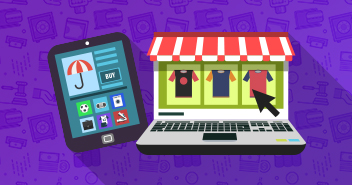
In today’s digital age, mobile commerce (m-commerce) has transformed the way we shop and conduct business transactions. With the widespread adoption of mobile devices and internet accessibility, consumers can now conveniently engage with businesses anytime, anywhere.
This convenience has revolutionized the retail industry and reshaped the customer experience.
M-commerce establishes direct and personalized connections with customers through features like push notifications, location-based services, and tailored recommendations. These capabilities open new opportunities for businesses to enhance customer loyalty and drive sales.
In this blog, we explore the latest trends, key statistics, best practices, challenges, and future prospects of mobile commerce. By the end, you will gain valuable insights to thrive in this dynamic digital transaction landscape.
Mobile Commerce Trends

A. Growth of Mobile Commerce
Mobile commerce has been experiencing tremendous growth in recent years and shows no signs of slowing down. With the increasing penetration of smartphones and improved internet connectivity, more consumers are turning to their mobile devices for shopping.
According to the latest statistics, in the US, mobile commerce sales accounted for almost 42% of total ecommerce sales in 2022. Looking ahead to 2023, it is projected that retail m-commerce sales will represent over 43% of total sales, with an estimated increase to 44% by 2025.
With these impressive figures, the potential for mobile commerce growth is undeniable. This growth is fueled by the convenience and accessibility that mobile devices offer to consumers.
Supercharge Your Online Store with Cloudways Managed Ecommerce Hosting!
Experience the power of Cloudways’ managed ecommerce hosting solution tailored for online stores. Benefit from high-performance infrastructure, enhanced security, and scalable resources.
B. Rise of Mobile Shopping Apps
Mobile shopping apps have become a prominent trend in mobile commerce. Retailers and e-commerce businesses are developing dedicated apps to provide seamless and personalized shopping experiences.
These apps offer features such as one-click purchasing, personalized recommendations, and in-app promotions. They also leverage push notifications to engage and retain customers. The convenience and tailored experiences offered by mobile shopping apps have contributed to their increasing popularity.
C. Mobile Payments and Digital Wallets
The widespread adoption of mobile payments and digital wallets has ushered in a transformative era in the realm of consumer transactions. This revolutionary shift has redefined the way individuals engage in financial exchanges.
With the advancement of secure payment technologies, such as Near Field Communication (NFC) and biometric authentication, consumers can now make quick and secure payments using their mobile devices.
Digital wallet providers like Apple Pay, Google Pay, and Samsung Pay have gained traction, offering users a convenient and streamlined checkout process.
D. Augmented Reality and Virtual Reality in Mobile Commerce
Augmented reality (AR) and virtual reality (VR) technologies are making their way into mobile commerce, transforming the shopping experience. AR enables users to visualize products in real-world environments, enhancing the decision-making process.
VR, on the other hand, immerses users in virtual shopping environments, replicating the experience of being in a physical store. These technologies allow consumers to explore and interact with products in innovative ways, leading to increased engagement and conversion rates.
E. Voice Commerce and Chatbots
The rise of voice assistants, such as Amazon’s Alexa, Apple’s Siri, and Google Assistant, has given impetus to voice commerce. Consumers can now use voice commands to search for products, place orders, and make inquiries.
Additionally, chatbots powered by artificial intelligence (AI) are being deployed to provide instant customer support and personalized recommendations. These conversational interfaces are revolutionizing customer interactions and simplifying the purchasing process.
Mobile Commerce Statistics
Now that we’ve examined the present trends, let’s delve into some fascinating statistics surrounding mobile commerce.
A. Global Mobile Commerce Revenue

Source: Polaris Market Research Analysis
By 2030, it is projected that global mobile commerce revenue will reach an impressive USD 1,901.18 billion. This forecast highlights the continuous growth and potential of mobile commerce as a significant revenue stream in the digital landscape.
B. Mobile Commerce vs. Desktop Commerce
When comparing mobile commerce to desktop commerce, mobile devices have taken the lead. Mobile traffic accounts for a substantial 60.66% of overall online traffic, while desktop traffic represents 37.08%.
This shift in consumer behavior reinforces the need for businesses to prioritize mobile optimization and cater to the preferences of mobile-savvy customers.
C. Impact of Mobile Optimization
Companies that have mobile-optimized websites significantly increase their chances of achieving higher mobile conversation rates. In fact, research suggests that businesses with mobile-optimized sites triple their likelihood of achieving a mobile conversation rate of 5% or above.
This emphasizes the importance of responsive design and mobile optimization in driving successful mobile commerce strategies.
Best Practices for Mobile Commerce
To succeed in the dynamic world of mobile commerce, businesses must adopt and implement best practices that enhance the mobile shopping experience for customers. Here are key strategies to consider:
A. Responsive Design and Mobile Optimization
A mobile-optimized website with a responsive design is essential for providing a seamless and user-friendly experience across different screen sizes. Ensuring that the website loads quickly, has intuitive navigation, and displays content properly on mobile devices will significantly improve engagement and conversion rates.
B. Simplified Checkout Process
Streamlining the checkout process is crucial to reduce friction and cart abandonment. Implementing features like guest checkout, auto-fill forms, and multiple payment options can simplify the purchase journey and improve conversion rates. Moreover, integrating secure and trusted payment gateways instills confidence in customers.
C. Personalization and User Experience
Leveraging data and personalization techniques can enhance the user experience in mobile commerce. Tailoring product recommendations, offering personalized offers and discounts, and providing relevant content based on user preferences can significantly boost engagement and customer loyalty.
D. Mobile Marketing and Push Notifications
Mobile marketing campaigns, including targeted advertisements, in-app messaging, and push notifications, enable businesses to reach and engage customers directly on their mobile devices. Leveraging personalized and timely communication can drive conversions, promote offers, and increase customer retention.
E. Mobile Security and Trust
Mobile commerce relies on customer trust and security. Implementing robust security measures, including SSL certificates, encryption, and secure payment gateways, is essential to protect customer data and instill confidence in the shopping experience.
Optimize Your Ecommerce Success with Cloudways Managed Hosting!
Unlock the full potential of your online store with Cloudways’ managed ecommerce hosting. Enjoy lightning-fast load times, seamless scalability, and expert support.
Challenges and Future of Mobile Commerce
While mobile commerce presents numerous opportunities, it also has its fair share of challenges. Addressing these challenges is crucial for businesses to thrive in the mobile commerce landscape. Here are key challenges to consider:
A. User Experience and Mobile Optimization
Delivering a seamless user experience across various devices and screen sizes remains a challenge. Ensuring consistent performance, intuitive navigation, and fast loading times on mobile platforms require continuous optimization and testing.
B. Security and Trust
Mobile commerce faces security concerns, including data breaches, fraud, and unauthorized access. Businesses must invest in robust security measures, implement secure payment gateways, and educate users about mobile security practices to build trust and safeguard customer information.
C. Fragmentation of Devices and Operating Systems
The diversity of mobile devices, screen sizes, and operating systems poses a challenge for businesses to provide consistent experiences. Developing and maintaining compatibility across various platforms requires additional resources and testing efforts.
D. Payment Gateways and Infrastructure
Integrating reliable and user-friendly payment gateways that support various payment methods can be challenging. Businesses need to navigate different regional payment preferences, compliance regulations, and evolving payment technologies.
E. Evolving Customer Expectations and Technology
Keeping up with evolving customer expectations and technological advancements is a continuous challenge. Businesses must stay updated on emerging technologies, such as voice commerce, augmented reality, and chatbots, and adapt their strategies accordingly.
Looking to the future, mobile commerce holds immense potential. The widespread adoption of 5G technology promises faster and more reliable mobile connectivity, opening doors for enhanced experiences, seamless transactions, and increased customer engagement.
Additionally, emerging technologies like AI, machine learning, and blockchain are expected to shape the future of mobile commerce, enabling personalized experiences, improved security, and streamlined processes.
Conclusion
Mobile commerce has transformed the way businesses and consumers engage in transactions, with significant growth in global revenue and the dominance of mobile devices.
To succeed, businesses must adapt to trends, implement best practices, and overcome challenges like mobile optimization and security. The future of mobile commerce looks promising with advancements like 5G and emerging technologies.
Staying updated and embracing innovative strategies will be crucial for businesses to remain competitive. By providing seamless experiences, personalization, and security, businesses can drive sales and foster customer loyalty. Check out Cloudways support.
As the mobile commerce landscape evolves, agility and customer-centricity are key. By leveraging the potential of mobile commerce and its best practices, businesses can thrive in this era of digital transactions.
Q1. What are the benefits of mobile commerce for eCommerce retailers?
A. Here are a few of the benefits of mobile commerce for eCommerce retailers:
- Improved customer experience
- Increased product discovery
- Reach a wider audience
- Capitalize on impulse purchases
- Better data and analytics
- Greater engagement and communication
- Optimized user experience (UX)
- Quicker checkout process
Q2. What is the difference between e-commerce and mobile commerce?
A. Here are the differences between the two:
- E-commerce: Buying and selling goods online using the internet.
- Mobile commerce: Buying and selling goods using mobile devices like smartphones or tablets.
Q3. What are the elements of mobile commerce?
A. Here are a few crucial elements of mobile commerce:
- Mobile commerce applications
- Mobile stations (devices)
- Mobile middleware
- Wireless networks
- Wired networks
- Host computers
Q4. Can you provide an example of an m-business?
A. Food delivery service operating through a mobile app, allowing users to order food using their smartphones anytime, anywhere, is an example of an m-business.
 |
Shifa A.Kader is a digital marketer and a content writer working at Oyelabs Technologies. She is passionate about creating content and discovering new Digital Marketing trends that help upscale startups and other enterprises. |
Abdul Rehman
Abdul is a tech-savvy, coffee-fueled, and creatively driven marketer who loves keeping up with the latest software updates and tech gadgets. He's also a skilled technical writer who can explain complex concepts simply for a broad audience. Abdul enjoys sharing his knowledge of the Cloud industry through user manuals, documentation, and blog posts.


